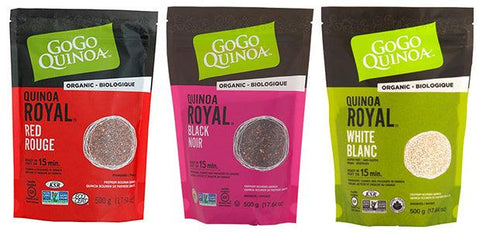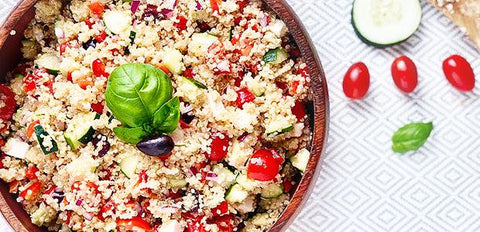Quinoa.
It's a word we've been hearing everywhere for the past few years. Appearing in cookbooks, on restaurant menus and in newspapers, quinoa seems to have made its way into our lives.
Let's get to know quinoa better: a superfood that in 2013 had an international year in its name.
What is quinoa?
Quinoa is a seed from the family of amarantaceae family harvested in South America for over 7,000 years. The Incas gave the name mother of all grains to this nutritious food that they considered as sacred. 1
According to its botanical classification, quinoa is not a grain since it does not come from a cereal. More like the spinach seed and the beet, quinoa has braved the time scale because of its nutritional value, its versatility and its nutty taste.1,2
Although quinoa has grown worldwide in recent years, its main production is still in its countries of origin, Bolivia and Peru. 1
Why do we hear so much about quinoa?
For thousands of years, quinoa was unknown to the North American people. However, for the past few years, quinoa has been all the rage in our kitchens.
Quinoa has been getting a lot of attention since the emergence of two food phenomena: veganism and gluten-free.
Indeed, quinoa is a seed that brings a lot of versatility to the vegan diet. Cooked like a grain, quinoa is one of the few plant foods that provides a complete source of protein. 3
Since the rise of gluten-free awareness, more than 10 million Canadians (or one in three) look for gluten-free products in stores.4 Quinoa offers these consumers a healthy and nutritious alternative.
Are there different kinds of quinoa?
There are more than 3,000 types of quinoa.2
However, the most popular ones are quinoa white, red and black. You can also find blends with red and white or the tricolor. The white quinoa is the most commercialized as it has a slightly sweeter taste than its brothers and sisters.
Quinoa exists in its whole form, small flattened seeds with a caviar-like texture whose appearance is reminiscent of millet, but also in flakesin flour or soufflé.
Is quinoa nutritious?
Quinoa is a much more nutritious alternative to its grain counterparts, including wheat and brown rice.
1 cup of cooked quinoa offers 5:
- 8 grams of complete protein
- 5 grams of fibre
- A significant amount of manganese, magnesium, phosphorus, folate, copper, zinc and iron
Quinoa is also rich in phytonutrients and antioxidants, compounds with antiviral, anticancer and antidepressant effects. 6

What are the health benefits of quinoa ?
Quinoa has a low glycemic index. In other words, it does not disturb the blood sugar balance and can fight against diabetes and obesity. 9
Thanks to its interesting nutritional profile, quinoa improves the health of people following a gluten-free diet. Indeed, products marketed without gluten are often highly processed and depleted of nutrients. On the other hand, quinoa is nutritious and contributes to a better glycemia and lower triglycerides. 10
With its fiber and protein content, quinoa is a good ally for weight loss.
Moreover, this superfood is rich in antioxidants, anti-aging and anti-cancer compounds. 11
How to eat quinoa?
Quinoa is a very versatile seed.
For breakfast, it is prepared as porridge with breakfast flakes or by cooking the whole seeds in a large quantity of liquid to which fruit, seeds, nuts and syrup are added.
As a snack, quinoa can be made into muffins, added to candy bars, or added to these chocolate crisp squares.
For the main meal, quinoa can be served as a side dish instead of rice, in a salad, or even in sushi. This quinoa shepherd's pie and our Greek salad with quinoa are other examples of uses. For even more versatility, the company GoGo Quinoa offers quinoa-based pasta products. Try the fusilli, spaghetti and macaroni.
For a sugar craving, you can make a quinoa crumble, a chocolate cakeor nibble on these double chocolate quinoa cookies.
How to cook quinoa?
When preparing quinoa yourself, most of the time you use the whole form.
The seeds should be rinsed vigorously to remove the saponin, a bitter compound found in the quinoa husk that inhibits the absorption of certain minerals and can cause digestive discomfort. Some people will also soak the quinoa to improve its digestibility. 7
Once rinsed and/or soaked, the quinoa is cooked in 1.5 times its volume. It is cooked quickly: barely 15 minutes and the quinoa is cooked, soft and full of water.
Who can eat quinoa?
Quinoa is accessible to everyone. Since it is vegan and gluten-free, it is suitable for most alternative diets. Only the followers of paleo and ketogenic diets will choose to avoid it.
However, some people may experience allergic symptoms. Generally, it is a reaction to a bad preparation.
The saponin in the quinoa shell can be allergenic to some people and cause acute digestive discomfort, breathing difficulties or hives. This is why quinoa should always be rinsed thoroughly before cooking. 8
Now that you are quinoa experts, enjoy the products GoGo Quinoa to discover a range of products made with this superfood.
Go Quinoa!
Véronique Cousineau, ND
verosante.com
Sources
1: "The Global Expansion of Quinoa: Trends and Limits." Bazile, Didier, Sven-Erik Jacobsen, and Alexis Verniau. Frontiers in Plant Science 7 (2016): 622. PMC. Web. 10 Sept. 2018.
2: Nutrition facts and functional potential of quinoa (Chenopodium quinoa willd.), an ancient Andean grain: a review. Antonio Vega-Gálvez, Margarita Miranda, Judith Vergara, Elsa Uribe, Luis Puente, Enrique A. Martínez J Sci Food Agric. 2010 Dec; 90(15): 2541-2547.
3: Nutritional value. Secretariat of the International Year of Quinoa. Food and Agriculture Organization of the United Nations. 2013.
4: Consumers of gluten-free products. Gluten-free claims in the marketplace. Agriculture and Agri-Food Canada.
5 : Quinoa, cooked. Self-nutrition DATA.
6 : Total antioxidant capacity and content of flavonoids and other phenolic compounds in canihua (Chenopodium pallidicaule): an Andean pseudocereal. J. Mauricio Peñarrieta, J. Antonio Alvarado, Björn Akesson, Björn Bergenståhl Mol Nutr Food Res. 2008 Jun; 52(6): 708-717.
7: Quinoa - a Review. Michala JANCUROVÁ, Lucia MINAROVIČOVÁ and Alexander DANDÁR. Department of Food Science and Technology, Faculty of Chemical and Food Technology, Slovak University of Technology. Vol. 27, 2009, No. 2: 71-79.
8 : Am I allergic to saponin? Medical News Daily. Rachel Nall, RN, BSN, CCRN. Reviewed by Elaine K. Luo, MD. 6 June 2018
9: Glycemic index: overview of implications in health and disease. David J. A. Jenkins, Cyril W. C. Kendall, Livia S. A. Augustin, Silvia Franceschi, Maryam Hamidi, Augustine Marchie, Alexandra L. Jenkins, Mette Axelsen. Am J Clin Nutr. 2002 Jul; 76(1)
10: In vitro starch digestibility and in vivo glucose response of gluten-free foods and their gluten counterparts. Cristiana Berti, Patrizia Riso, Lucilla D. Monti, Marisa Porrini. Eur J Nutr. 2004 Aug; 43(4): 198-204.
11: Evaluation of indigenous grains from the Peruvian Andean region for antidiabetes and antihypertension potential using in vitro methods. Lena Galvez Ranilla, Emmanouil Apostolidis, Maria Ines Genovese, Franco Maria Lajolo, Kalidas Shetty. Journal of Med Food. 2009 Aug; 12(4): 704-713.




